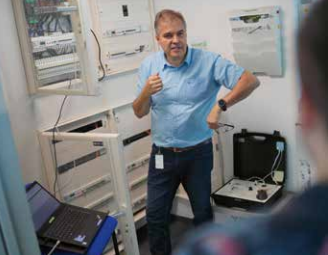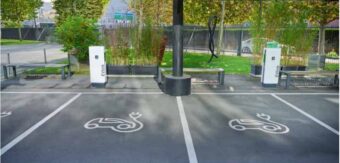
The need for decarbonization and reducing greenhouse gas emission has reached its peak and the important part of the entire process lies in electromobility and efforts to reduce pollution produced by the means of transportation to a minimum. Serbia joins this trend and the slogan of this year’s Belgrade Car Show “Natural RPM” is the very reflection of that. Vehicles with environmentally advanced power solutions, electric cars and hybrids are ever more in the spotlight so we discussed trends and future of the electric mobility with Darko Zeljković, Offer Manager in Schneider Electric.
EP: Schneider Electric is a leading company in energy management and automation sector and one of the most influential companies when it comes to sustainability. In addition to industrial software, you’re also focused also on software which contribute to electric mobility, as well as chargers for electric vehicles. What does Schneider offer in our market?
Darko Zeljković: In the field of eMobility, in the Serbia and Montenegro markets, Schneider Electric, with its network of specialized partners, offers products and solutions under a single commercial name EcoStruxure™ for eMobility. In addition to several models of EVlink AC chargers with up to 22W of total power, and DC chargers with up to 24kW of total power, we also develop and offer software solutions in order to provide smart and efficient charging of electric vehicles. In the first place, I would like to single out our EcoStruxure™ EV Charging Expert. Adding infrastructure for charging of electric vehicles increases electricity consumption in a facility. In order to avoid overload and possible “outages” of electric power systems in facilities, Schneider Electric has developed this solution to manage burdened infrastructure for charging of electric vehicles, access management and monitoring of chargers. With this solution you can control functioning of up to 1,000 charging stations in a multizone regime and at the same time provide adequate prioritization for users of chargers.
In focus:
EP: The company also participated at this year’s Car Show. Can you tell us more about your impressions, and do you believe that now there are more car industry lovers who believe that there is a need to transfer to electric vehicles and hybrid vehicles?
Darko Zeljković: Yes. This is the first time that our company participated at the Car Show in Serbia. Having in mind that this year’s Car Show was an eco show and that leading manufacturers in the car industry presented their models of Plug-In hybrid and electric vehicles, our decision to be present there was a logical one. And I don’t refer only to the chargers, but protective equipment used upon the installation of the chargers and distribution systems for safe distribution of electric energy to supply the chargers. I’m personally very pleased with the number of people who showed interest in products we presented, which is certainly one of the indicators that there is an increasing number of drivers ready to use electric vehicles and installation of chargers in their yards and garages. I’m also especially glad that there is also an increasing number of investors building residential and business facilities, we had an opportunity to talk to at the fair, who are ready to provide parking spots with electric vehicles chargers to their clients. I also believe that car exhibitors who took part at the fair are satisfied with their participation.
EP: Schneider has already installed a certain number of chargers for electric vehicles across Serbia and the region. What chargers we are talking about and are the market requirements for electric chargers satisfied?
Darko Zeljković: With its products and solutions, Schneider Electric has been present in the market of electric vehicle chargers since 2011, and almost 160,000 AC and DC charging points have been installed across the globe so far. In Serbia and Montenegro, this market embarked on an active development 4 to 5 years ago, and we now have almost 320 installed chargers with one or two connectors. They are mainly smart AC chargers with 7.4kW, 11kW and 22 kW of total power. Considering the current number of electric cars in Serbia and Montenegro, maybe it is safe to say that the need for electric chargers has been satisfied. But, if we take into account trends in the car industry and in the field of eMobility in the world which would most certainly spill over Serbia and Montenegro in the future, the current number of installed chargers, especially those publicly available, certainly is not enough to encourage owners of electric vehicles to come and visit us in their favourite vehicles, or stop on their way to a different destination.
EP: Can you tell us more about global trends when it comes to eMobility and what is awaiting us in the near future?

Darko Zeljković: One of the global trends with a major impact on the direction of development and electrification of traffic is most certainly Urbanisation. According to experts, we can expect 2.5 bn people more to relocate to cities until 2050. One of the ways to protect the environment and reduce the emission of greenhouse gases to a minimum is an increasing number of electric vehicles. We expect the running cost of EVs per km to be much lower than costs of cars with an internal combustion engine very soon. Some conservative forecasts say that until the end of the next decade, one in three vehicles sold in the world will be an electric vehicle whereas more optimistic predictions announce even higher percentage. Therefore, further development of the network of electric chargers is a very important step, and estimations confirm that up to 500 million of charging points for electric vehicles will be installed until 2040.
EP: Having all this in mind, what will Schneider Electric focus on in the upcoming period?
Darko Zeljković: The majority of existing policies focuses on the installation of public infrastructure for charging today. It is very important to develop a network of publicly available chargers along highways, in the vicinity of key traffic road links and public transport stations. However, cca 90 per cent of chargers installed until 2040 will be private settings, mainly in our residential, commercials and industrial buildings. The expected exponential growth of EV chargers in this market segment will have an increased electricity consumption as a consequence. That is why Schneider Electric continues to develop different series of AC and DC chargers, as well as software solutions, in order to provide “smart charging” and top-level user experience. In addition, during the traffic electrification process with an aim to produce “green electric energy”, the maximum use of renewable energy sources (solar electric power plants, wind parks etc) is imposed as an imperative, together with energy storage systems whereas individual producers/consumers, the so-called prosumers, will account for an important segment of an active and decentralized electric energy system with their own capacities. Schneider Electric has already imposed itself as a leader in digitalization of electric energy and decentralization of electric energy systems with its solutions, something that will pose one of the core preconditions for proper functioning of all systems in the future, including the network of EV chargers.
Interviewed by: Milica Marković
Read the story in the new issue of the Energy portal Magazine RENEWABLE ENERGY SOURCES.


